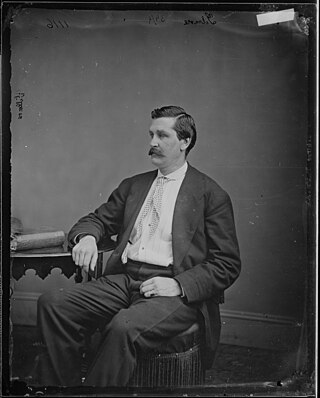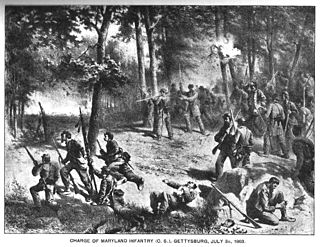
The American Civil War was a civil war in the United States between the Union and the Confederacy, formed by states that had seceded from the Union. The cause of the war was the dispute over whether slavery would be permitted to expand into the western territories, leading to more slave states, or be prevented from doing so, which many believed would place slavery on a course of ultimate extinction.

Glen Burnie is an unincorporated town and census-designated place (CDP) in Anne Arundel County, Maryland, United States. It is a suburb of Baltimore. The population was 72,891 at the 2020 census.

In the context of the American Civil War (1861–65), the border states were slave states that did not secede from the Union. They were Delaware, Maryland, Kentucky, and Missouri, and after 1863, the new state of West Virginia. To their north they bordered free states of the Union, and all but Delaware bordered slave states of the Confederacy to their south.

John Adams Dix was an American politician and military officer who was Secretary of the Treasury, Governor of New York and Union major general during the Civil War. He was notable for arresting the pro-Southern Maryland General Assembly, preventing that divided border state from seceding, and for arranging a system for prisoner exchange via the Dix–Hill Cartel, concluded in partnership with Confederate Major General Daniel Harvey Hill.

"Maryland, My Maryland" was the state song of the U.S. state of Maryland from 1939 until 2021. The song is set to the melody of "Lauriger Horatius" — the same tune "O Tannenbaum" was taken from. The lyrics are from a nine-stanza poem written by James Ryder Randall (1839–1908) in 1861. The state's general assembly adopted "Maryland, My Maryland" as the state song on April 29, 1939.


Maryland Route 648 is a collection of state highways in the U.S. state of Maryland. These nine highways are current or former sections of the Baltimore–Annapolis Boulevard between Annapolis and Baltimore via Glen Burnie. There are five signed mainline segments of MD 648 through Arnold, Severna Park, Pasadena, Glen Burnie, Ferndale, and Pumphrey in northern Anne Arundel County; Baltimore Highlands in southern Baltimore County; and the independent city of Baltimore. MD 648 mainly serves local traffic along its meandering route, with long-distance traffic intended to use the parallel and straighter MD 2 south of Glen Burnie and freeway-grade Interstate 97 (I-97), I-695, and MD 295 between Glen Burnie and Baltimore.

Harry Ward Gilmor served as the Baltimore City Police Commissioner, head of the Baltimore City Police Department in the 1870s, and a Confederate cavalry officer during the American Civil War. Gilmor's daring raids, including Gilmor's Raid through northern and central Maryland in July 1864 during the third major Confederate invasion of the North gained his partisans fame as "Gilmor's Raiders".

During the American Civil War (1861–1865), Maryland, a slave state, was one of the border states, straddling the South and North. Despite some popular support for the cause of the Confederate States of America, Maryland did not secede during the Civil War. Governor Thomas H. Hicks, despite his early sympathies for the South, helped prevent the state from seceding.
The American Civil War bibliography comprises books that deal in large part with the American Civil War. There are over 60,000 books on the war, with more appearing each month. Authors James Lincoln Collier and Christopher Collier stated in 2012, "No event in American history has been so thoroughly studied, not merely by historians, but by tens of thousands of other Americans who have made the war their hobby. Perhaps a hundred thousand books have been published about the Civil War."

George Hume Steuart (1790–1867) was a United States general who fought during the War of 1812, and later joined the Confederate States of America during the Civil War. His military career began in 1814 when, as a captain, he raised a company of Maryland volunteers, leading them at both the Battle of Bladensberg and the Battle of North Point, where he was wounded. After the war he rose to become major general and commander-in-chief of the First Light Division, Maryland Militia.

Elias Glenn was a United States district judge of the United States District Court for the District of Maryland.

The Maryland Line in the Army of the Confederate States of America was made up of volunteers from Maryland who, despite their home state remaining in the Union, fought for the Confederate States of America during the American Civil War. Of approximately 25,000 Marylanders who volunteered, most fought in the Army of Northern Virginia, and it was not until late in 1863 that a Maryland Line in the CSA was formally created. However, by this late stage in the war, few men wished to leave the units they had fought alongside for more than two years, and the exiles' dream of an independent Maryland Line in the Confederate army would never be fully realized.

The Steuart family of Maryland was a prominent political family in the early History of Maryland. Of Scottish descent, the Steuarts have their origins in Perthshire, Scotland. The family grew wealthy in the early 18th century under the patronage of the Calvert family, proprietors of the colony of Maryland, but would see their wealth and status much reduced during the American Revolution, and the American Civil War.
Like other border states, Maryland found herself in a difficult position at the start of the American Civil War, with loyalties divided between North and South. Although Maryland herself remained in the Union, Maryland militia units fought on both sides of the Civil War. Many militia members travelled south at the start of the war, crossing the Potomac River to join the Confederate Army of Northern Virginia.

The Winans Steam Gun was a steam-powered centrifugal gun used during the American Civil War, which used centrifugal forces to propel projectiles.
The American Civil War bibliography comprises books that deal in large part with the American Civil War. There are over 60,000 books on the war, with more appearing each month. There is no complete bibliography to the war; the largest guide to books is over 40 years old and lists over 6,000 titles selected by leading scholars. Many specialized topics such as Abraham Lincoln, women, and medicine have their own lengthy bibliographies. The books on major campaigns typically contain their own specialized guides to the sources and literature. The most comprehensive guide to the historiography annotates over a thousand titles.
In general the bibliography of the American Civil War comprises over 60,000 books on the war, with more appearing each month. There is no complete bibliography to the war; the largest guide to books is over 40 years old and lists over 6,000 titles selected by leading scholars. The largest guides to the historiography annotates over a thousand titles.

The Daily Exchange was a daily newspaper published in Baltimore, Maryland, United States from 1858 to 1861. It was originally owned and edited by Charles G. Kerr and Thomas Hall Jr. In 1859, Henry Fitzhugh, William Carpenter, and Frank Key Howard bought into the paper. Howard soon headed the editorial staff and Severn Teackle Wallis contributed editorial columns frequently.

Fort Marshall was a historical American coastal four-point bastion fort located in what is now the Highlandtown and Canton neighborhoods of Baltimore, Maryland. It was built at the outset the American Civil War in 1861, to protect the eastern approaches of Baltimore from Confederate attacks. The fort remained garrisoned for the duration of the war. After 1866, the fort's buildings were salvaged for other purposes and the area ultimately became the site of the Sacred Heart of Jesus Roman Catholic Church, surrounded by the developing residential neighborhoods of southeast Baltimore.
















